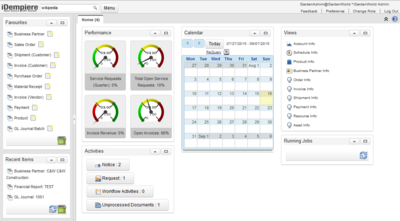| Developer(s) | zkoss |
|---|---|
| Stable release | 9.6.0 / 10 August 2021 [1] |
| Repository | |
| Operating system | Cross-platform (JVM) |
| Type | Ajax Web Framework |
| License | LGPL / ZOL / Commercial [2] |
| Website | zkoss |
ZK is an open-source Ajax Web application framework, written in Java, [3] [4] [5] that enables creation of graphical user interfaces for Web applications with little required programming knowledge.
Contents
- Features
- Differences from XUL
- System requirements
- Prerequisites of programming skills
- Required
- Optional
- ZUML
- Client-side technologies
- ZK Add-Ons
- See also
- References
- External links
The core of ZK consists of an Ajax-based event-driven mechanism, over 123 XUL and 83 XHTML-based components, [6] and a mark-up language for designing user interfaces. Programmers design their application pages in feature-rich XUL/XHTML components, and manipulate them upon events triggered by end user's activity. It is similar to the programming model found in desktop GUI-based applications.
ZK uses a server-centric approach in which the content synchronization of components and the event pipe-lining between clients and servers are automatically done by the engine, and Ajax plumbing codes are completely transparent to web application developers. Therefore, the end users get the similar engaged interactivity and responsiveness as a desktop application, while programmers' development retains a similar simplicity to that of desktop applications.
ZK does not use the standard web request-response mechanism and does not send form fields to the server by making a GET request with query parameters or a POST request. Instead, AJAX requests are sent to the server to update the internal state of each screen widget. At the browser, ZK only downloads a JSON description of the web page and uses a client renderer to turn that into a UI. It's quite efficient and under closer inspection, does not download everything at once. A look at the traffic between client and the server reveals several requests going back and forth between client and browser until the page rendering eventually completes.
The optional client-side customization allows the developer to leverage the client-side resources with the so-called server+client fusion, for customization and to reduce the Ajax traffic.
In addition to component-based programming in a manner similar to Swing, ZK supports a mark-up language for rich user interface definition called ZUML.
- ZUML is designed for non-programmer developers to design user interfaces intuitively.
- ZUML allows developers to meld different markup languages, such as Mozilla XUL language and XHTML, seamlessly into the same page.
- ZUML allows developers to embed scripts in pure Java language (interpreted by BeanShell) and use EL expressions to manipulate the components and access data.






